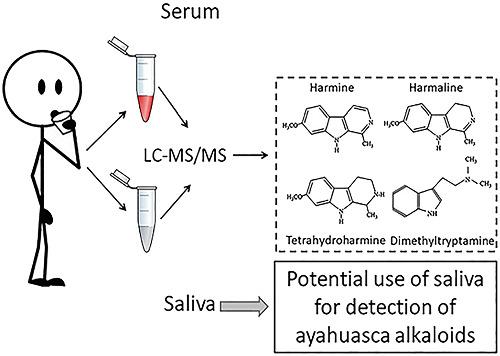当前位置:
X-MOL 学术
›
Drug Test. Anal.
›
论文详情
Our official English website, www.x-mol.net, welcomes your feedback! (Note: you will need to create a separate account there.)
Kinetic profile of N,N‐dimethyltryptamine and β‐carbolines in saliva and serum after oral administration of ayahuasca in a religious context
Drug Testing and Analysis ( IF 2.9 ) Pub Date : 2020-10-29 , DOI: 10.1002/dta.2955 Rafael Lanaro 1, 2 , Sueli Moreira Mello 1 , Kelly Francisco da Cunha 1 , Gabriela Silveira 1 , Nelson Francisco Corrêa-Neto 3 , Stephen Hyslop 2 , Oscar G Cabrices 4 , Jose Luiz Costa 1, 5 , Alessandra Linardi 3
Drug Testing and Analysis ( IF 2.9 ) Pub Date : 2020-10-29 , DOI: 10.1002/dta.2955 Rafael Lanaro 1, 2 , Sueli Moreira Mello 1 , Kelly Francisco da Cunha 1 , Gabriela Silveira 1 , Nelson Francisco Corrêa-Neto 3 , Stephen Hyslop 2 , Oscar G Cabrices 4 , Jose Luiz Costa 1, 5 , Alessandra Linardi 3
Affiliation

|
Ayahuasca is a beverage obtained from Banisteriopsis caapi plus Psychotria viridis. B. caapi contains the β‐carbolines harmine, harmaline, and tetrahydroharmine that are monoamine oxidase inhibitors and P. viridis contains N,N‐dimethyltryptamine (DMT) that is responsible for the visionary effects of the beverage. Ayahuasca use is becoming a global phenomenon, and the recreational use of DMT and similar alkaloids has also increased in recent years; such uncontrolled use can lead to severe intoxications. In this investigation, liquid chromatography–tandem mass spectrometry (LC–MS/MS) was used to study the kinetics of alkaloids over a 24 h period in saliva and serum of 14 volunteers who consumed ayahuasca twice a month in a religious context. We compared the area under the curve (AUC), maximum concentration (Cmax), time to reach Cmax (Tmax), mean residence time (MRT), and half‐life (t1/2), as well as the serum/saliva ratios of these parameters. DMT and β‐carboline concentrations (Cmax) and AUC were higher in saliva than in serum and the MRT was 1.5–3.0 times higher in serum. A generalized estimation equations (GEEs) model suggested that serum concentrations could be predicted by saliva concentrations, despite large individual variability in the saliva and serum alkaloid concentrations. The possibility of using saliva as a biological matrix to detect DMT, β‐carbolines, and their derivatives is very interesting because it allows fast noninvasive sample collection and could be useful for detecting similar alkaloids used recreationally that have considerable potential for intoxication.
中文翻译:

在宗教背景下口服死藤水后唾液和血清中 N,N-二甲基色胺和 β-咔啉的动力学特征
Ayahuasca 是一种从Banisteriopsis caapi和Psychotria viridis 中获得的饮料。B. caapi含有作为单胺氧化酶抑制剂的 β-咔啉、harmaline和四氢哈明,P. viridis含有N、N‐二甲基色胺 (DMT),负责饮料的视觉效果。死藤水的使用正在成为一种全球现象,近年来 DMT 和类似生物碱的娱乐用途也有所增加;这种不受控制的使用会导致严重中毒。在这项研究中,液相色谱-串联质谱法 (LC-MS/MS) 用于研究 14 名在宗教背景下每月服用两次死藤水的志愿者的唾液和血清中 24 小时内生物碱的动力学。我们比较了曲线(AUC),最大浓度(下面积Ç最大),时间达到Ç最大(牛逼最大),平均停留时间(MRT)和半衰期(牛逼1/2),以及这些参数的血清/唾液比率。DMT和β咔啉的浓度(C ^最大值)和AUC比在血清均唾液更高,MRT为更高1.5-3.0倍于血清中。广义估计方程 (GEE) 模型表明,尽管唾液和血清生物碱浓度存在很大的个体差异,但可以通过唾液浓度预测血清浓度。使用唾液作为生物基质来检测 DMT、β-咔啉及其衍生物的可能性非常有趣,因为它允许快速无创样品收集,并且可用于检测具有相当大潜在中毒潜力的类似的娱乐性生物碱。
更新日期:2020-10-29
中文翻译:

在宗教背景下口服死藤水后唾液和血清中 N,N-二甲基色胺和 β-咔啉的动力学特征
Ayahuasca 是一种从Banisteriopsis caapi和Psychotria viridis 中获得的饮料。B. caapi含有作为单胺氧化酶抑制剂的 β-咔啉、harmaline和四氢哈明,P. viridis含有N、N‐二甲基色胺 (DMT),负责饮料的视觉效果。死藤水的使用正在成为一种全球现象,近年来 DMT 和类似生物碱的娱乐用途也有所增加;这种不受控制的使用会导致严重中毒。在这项研究中,液相色谱-串联质谱法 (LC-MS/MS) 用于研究 14 名在宗教背景下每月服用两次死藤水的志愿者的唾液和血清中 24 小时内生物碱的动力学。我们比较了曲线(AUC),最大浓度(下面积Ç最大),时间达到Ç最大(牛逼最大),平均停留时间(MRT)和半衰期(牛逼1/2),以及这些参数的血清/唾液比率。DMT和β咔啉的浓度(C ^最大值)和AUC比在血清均唾液更高,MRT为更高1.5-3.0倍于血清中。广义估计方程 (GEE) 模型表明,尽管唾液和血清生物碱浓度存在很大的个体差异,但可以通过唾液浓度预测血清浓度。使用唾液作为生物基质来检测 DMT、β-咔啉及其衍生物的可能性非常有趣,因为它允许快速无创样品收集,并且可用于检测具有相当大潜在中毒潜力的类似的娱乐性生物碱。

























 京公网安备 11010802027423号
京公网安备 11010802027423号